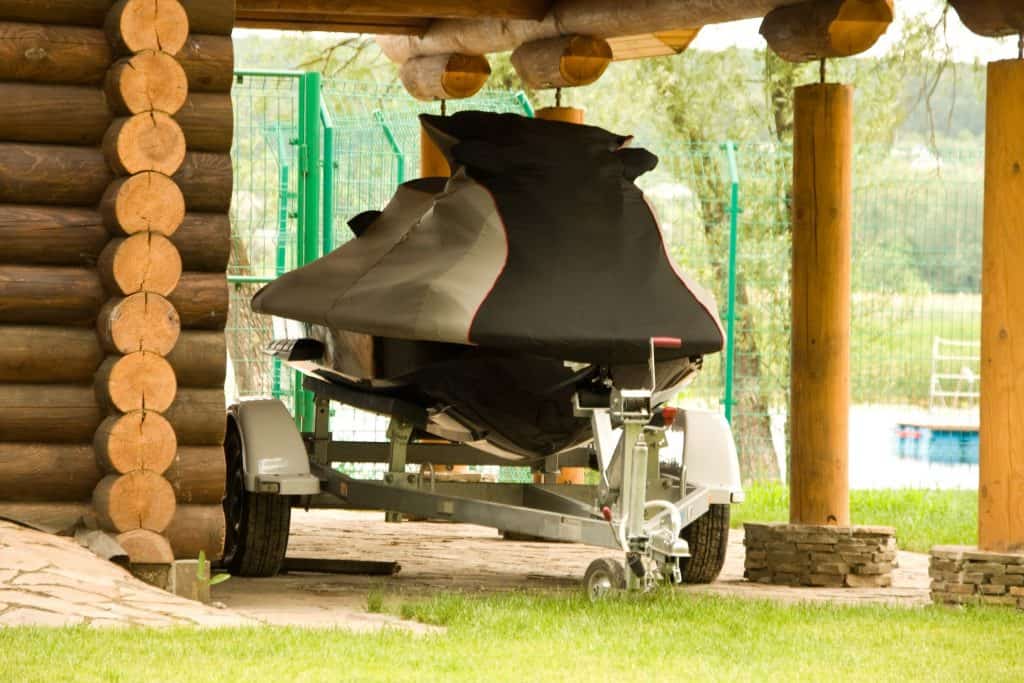
Once you get a jet ski, you may wonder what maintenance it needs, and how often. Every jet ski owner needs to know how to make sure your jet ski lives a long and healthy life.
Before you start the maintenance process for your jet ski, read through YOUR Owner’s Manual for specific things your jet ski needs to function.
Oil Change
An oil change is needed at least once a year. If you spend more than 50 hours a year riding your jet ski, then you may need to have it changed more often. Ask your manufacturer their opinion on how often you should have the oil changed.
After your first oil change (after one year of riding), some say you will only need one oil change every 100 hours. Oil gets contaminated with moisture and carbon so it is a good idea to keep an eye on how long you have been riding (in hours) since your last oil change.
The Sea-Doo SPARK can be ridden for 100 hours before your first oil change. All other models are 50 hours.
Battery
The battery in a jet ski will probably need to be replaced every 3 to 5 years. The higher the horsepower of your jet ski, the more often you will need to have your battery changed out. When you winterize your jet ski, you should pull the battery out and charge it throughout the winter. As long as you keep it charged when you are not using it, it should last a good 3-5 years.
Spark Plugs
The Spark Plugs need to be changed about once a year. Again, if you have an older jet ski that is a 2-stroke watercraft, they will need to be changed more often than if you have a 4-stroke. Some people with 2-stroke engines suggest to change them every 20 hours or every 4th or 5th ride. It is a smart idea to keep some extra onboard just in case you get a dud and cannot start your jet ski up. They are only $2 a piece so it is not too expensive to be prepared when it comes to spark plugs.
Flushing Out Fluids
Drain and replace all fluids remaining in your jet ski at the end of your jet skiing season. Make sure you empty and replace the fuel, motor oil, and oil filter. Jet skis with two-stroke engines most likely require a pre-mixture of fuel AND oil placed into the same tank. The four-stroke engine watercraft will typically have separate fill tanks for fuel and oil.
How to Winterize Your Jet Ski

- Get your jet ski positioned in the draining position. Make sure the front is higher up than the rear so you can drain it properly. Position it carefully on your trailer.
- Turn the jet ski on and move the throttle back and forth in fast short bursts. To prevent overheating, do not exceed this process for more than 30 seconds. Continue until all of the water is out.
- Mix RV antifreeze with water to prevent liquids from freezing inside your jet ski. Mix one gallon (3.8 L) of RV antifreeze with one gallon (3.8 L) of water in a 5-gallon bucket.
- Hook up a hose or water pump to your flush outlet with the other end inside the water/antifreeze solution. Once the entire mixture has gone through the engine turn it off.
- Fill up a bucket with warm water and some car safe soap. Wipe down the entire exterior focusing on the bottom of the jet ski where slime and algae usually build up.
- Rinse your jet ski well and then let the jet ski completely air dry. If you want, you can also out some high shine wax to buff and shine.
- Add a bottle of fuel stabilizer to your gas tank according to the label instructions. This will help prevent contamination and residue from building up.
- Top off your gas tank with PREMIUM gas. This will prevent condensation covering the inside of your gas tank.
- Spray lubricant such as WD40 on rotating parts of your jet ski. These include the steering nozzle, reverse, and brake mechanisms and the engine along with electrical components.
- Disconnect the negative terminal of the battery and then disconnect the positive. Take your entire battery out and charge it while your jet ski is stored. Make sure the battery is charging in a spot where the temperature will not drop below freezing.
- The best place to store your jet ski is on a trailer in a garage away from flammable substances. It is a smart idea to remove the tires from the trailer you are keeping your jet ski on to prevent it from moving around.
- The last step is to cover your jet ski. Use an actual jet ski cover or a tarp. If you do store it in a shed, or outside where rodents are, make sure your jet ski is covered extra times. Do not forget to plug the exhaust outlets and air intakes with rags.
How to De-Winterize Your Jet Ski
- Make sure the battery that you have been charging is fully charged before putting it back in your jet ski. If the battery is not charged all the way, get a new one.
- Drain all of the fluids in your jet ski; the fuel and the motor oil. Refill with new oil and fuel.
- Grease and then seal all of the bearings to make sure everything stays lubricated and kept away from salt, sand, and dirt. If your steering wheel is hard to turn, grease it up until you can easily turn it. Spray WD-40 on your whole engine.
- Inspect every single wire, cable, and belt to see if there are any cracks, wear, and tear, or looseness. If there are any that are damaged in any way, replace them.
- New jet ski spark plugs should be installed after you de-winterize your jet ski. Double check in your Owner’s Manual that you are getting the correct ones.
- With water connected, turn your engine on for about 5 minutes to make sure everything is working correctly.
- Wash your jet ski with warm water and car safe soap. Rinse all of the soap off and make sure it air dries.
Damaged Parts to Lookout For
It is very important to make sure that you bend down and look under your jet ski often. If there are any holes or fiberglass exposed on the bottom, you will need to get these fixed so that your jet ski does not get anything inside that could damage it.
Check to make sure your pump is clear and clean. There should be no rocks or sticks in it. It is important to check the wear ring as well so there is no damage to the impeller.
Make sure your compression is where it should be. Look up exactly where the specs should be to see the right compression for your jet ski. If it is lower than 100 PSI or if one cylinder is 150 PSI and the other is 110 PSI then your engine is in bad shape and is dying. It is vital to be aware of the compression. Know that it is normal for one cylinder to be 5 PSI higher than the other; a small difference is not a problem.
Check the lights on the gauge and make sure they all work when the vehicle is turned on.
Make sure the trailer that you have for your jet ski is in tip-top shape. Specifically, check the screws and welds to make sure they are not falling apart. If you see some rusting starting to happen, replace the screws right away.
When starting up your jet ski, take note of how easy or how hard it is to start it up. Is your battery getting old? Make sure you do not get stranded because you risked using your old battery. Keep it up to date.
How Expensive is Maintenance of a Jet Ski
Not only do you have to pay for the jet ski itself, but also all of the maintenance that comes with it. Here are some ideas of the numbers you should expect to pay in full for your jet ski.

- Insurance: What you are expected to pay for insurance on your jet ski depends on many different factors. Take into account your age, what horsepower your machine is, what kind of jet ski you have, how many people can ride on it, how often you will ride it, where you will ride it, where you will store it, and many more factors. One average per year is around $300.
- Service Cost: There will be some services that you cannot do yourself when it comes to your jet ski. Engines in jet skis are not as simple as an engine in a lawnmower, so if you do not have the experience I would suggest taking it to someone who does know. Each dealer charges different rates, making it hard to pin down an exact cost for each year. It is going to be a decent amount because the oil change, battery, spark plugs, winterizing, and all miscellaneous will all be a part of this service. Winterizing itself is around $500.
- First Service: This may not be the most convenient thing to do, but it is required with most jet skis that the first service is done at 10 hours of riding. The first service can be a hassle, but it is the most important service you will ever get. There is a break-in period where you have to take it nice and easy on your jet ski for the first 5 to 10 hours to make sure everything is in good shape. This first service is usually never included in when you buy your jet ski from the dealership just so you know.
- Pick-Ups and Drop-Offs: If you do not have your own trailer than you will need to contact a dealer or repair shop that you can pay to pick up your watercraft and drop off at lake access. The farther away they have to travel to get your jet ski will result in a more expensive bill.
- Repairs: It is recommended that you buy a warranty with your jet ski so that when things do break, they will be taken cared of after the deductible is paid. It is true that there are fewer problems associated with the 4-Stroke because of the better build. However, both the 4-stroke and the 2-stroke have problems. If you want to keep your jet ski in great shape with as little damages as possible, I would suggest getting it serviced every year and getting a solar panel battery charger.
- Final Budget: Aside from the monthly payment of the jet ski itself, you are going to need at least another $100 a month. In one example, you could be spending $1,200 extra a year, with half of that covering insurance and the other covering services and repairs. Just like a car is a big financial commitment, a jet ski is the same. The best thing to do to calculate how much a jet ski will cost you total every year is to call an insurance agent and ask for insurance quotes. Also, call your local dealer and ask about the prices they ask for their specific services.

Why Does a Jet Ski Need to be Winterized?
When you are not going to use your jet ski for the winter months, it is VITAL to have it winterized. If you do not properly have it winterized you are at risk for even more expensive repairs than winterizing itself.
Your jet ski may never be able to start up again because of the damages to the engine and the pumps. The last thing you want is to have to pay for engine repairs that are more expensive than the value of the actual jet ski.
You should never run the engine for more than 30 seconds at a time when it is out of the water.
You need to wash and dry your jet ski correctly because if there is any water inside it could easily freeze and cause damage to your engine. Old gas inside your tank can eat away and ruin your tank. Contamination is a possibility and can ruin your hoses, tank, and most detrimental your engine. Not oiling up your metal parts will result in corroding. Save your pump bearings by changing the jet ski’s pump oil.
When the battery is not taken out of your jet ski during storage, the battery will drain and you will have to drop $100-$200 on a new one next season. If you live in a place where temperatures fall below freezing often, you will need to add antifreeze to the cooling system so that water will stay out. Do not use regular automotive antifreeze because it is very harmful to the environment. Use RV antifreeze ONLY.
Maintaining any type of toy can prove to be quite expensive, but in the long run, if you take great care of it, it will last a lot longer and save you the purchase of a brand new jet ski for years.
